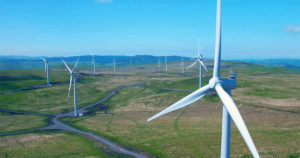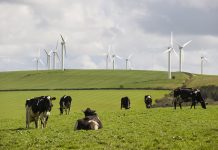 With just one year to go until the eyes of the world are on Glasgow for the UN Climate Change Conference (COP26), ScottishPower Renewables (SPR) has achieved what is believed to be a global first – using energy from a 69MW onshore windfarm to re-energise part of the power grid.
With just one year to go until the eyes of the world are on Glasgow for the UN Climate Change Conference (COP26), ScottishPower Renewables (SPR) has achieved what is believed to be a global first – using energy from a 69MW onshore windfarm to re-energise part of the power grid.
The successful project, at Dersalloch windfarm in South Ayrshire, proves wind power can restore a ‘blacked-out’ section of the transmission network. ‘Black start’ restoration – the name given to the procedure used to restore power in the event of a total or partial shutdown of the electricity transmission system – is often reliant on traditional fossil fuels like coal and gas.
So, using renewables to do this is not just an extraordinary achievement, but a pioneering world first that has the potential to transform how power could be restored to the network.
The project saw SPR partner Siemens Gamesa Renewables Energy (SGRE) to deploy the latest technology at the windfarm. SPR and SGRE worked in collaboration with SP Energy Networks (SPEN) when it was time to interact with the grid. This highly innovative project also received part-funding from the Scottish Government.
It used ‘grid-forming’ technology called virtual synchronous machines (VSM) to regulate the frequency and voltage of the power from the turbines – essentially forming a stable network island – to keep the electricity system stable and balanced. The technology was then used to integrate that supply with the grid and restore the part of the system that had been blacked out.
Paul Wheelhouse, Scotland’s Energy Minister, said, “Over the past decade Scotland has delivered huge success in decarbonising the electrical energy generated in Scotland, with renewable electricity delivering the equivalent of more than 90% of the power needed to meet Scotland’s demand for electricity in 2019. It is important that wind farms, which provided 73% of Scotland’s renewable electricity generation, don’t only provide zero carbon energy, but can also deliver the technical services that older, now-closed power stations would have provided for the grid to deliver an effective ‘black start’ recovery in the event of a major power cut.
“The Scottish Government, recognising the value in stimulating innovation to identify ways in which Scotland’s vast renewable potential could also augment our capability to deliver a ‘black start’ response, has provided financial support of £550,000 to this project through our Low Carbon Infrastructure Transition Programme and I am delighted with the outcome. Now Dersalloch has achieved a world first in proving that a wind farm can deliver vital ‘black start’ services in the event of a wider power blackout, and this is a crucial step in ensuring that we can deliver timely recovery times from any such incident should it occur while helping underpin a sustainable security of supply of electricity in Scotland as we move towards an energy system that is consistent with Net Zero greenhouse gas emissions by 2045.
“This technology will be vitally important, not just in Scotland and the UK, but worldwide. As more countries follow Scotland’s lead in closing down polluting fossil fuel power stations and moving to a renewable electricity system, the market for services that deliver sustainable security of supply will grow and I am keen that Scotland can be at the heart of that.”
Lindsay McQuade, CEO of ScottishPower Renewables said, “What we’ve achieved at Dersalloch is truly world-leading and highlights the crucial role renewables will play in creating a decarbonised modern, smart electricity system. It’s also a fantastic example of collaboration and innovation to deliver something exceptional that will change how renewables interact with the grid forever. It’s no longer just about the raw power we generate, but the interplay of renewable generation and its characteristics with the overall grid system and its requirements for when power is needed and used.
“As wind is now the cheapest form of electricity generation, innovating our windfarms to be responsive zero-carbon power stations that enhance the network, improve system resilience and help deliver the cleaner and greener future needed to achieve net zero makes sense.”
“And this is just the start of the journey, which makes it so exciting. We will continue to work with SGRE at Dersalloch to ensure the VSM technology becomes a permanent feature, complemented by battery storage, to help us better meet the flexibility requirements of the network – and we expect that work to be well underway this time next year. We will also explore opportunities to incorporate the technology at other existing windfarm sites as well as build it into our plans for future developments, which will create a whole new era of pioneering windfarms.”
Frank Mitchell, CEO of SP Energy Networks, said, “Our involvement in this project has been invaluable and showcases how we can get the network started and put the lights back on using renewable energy sources.”
The trial allowed SPEN to gain knowledge about precisely how many turbines would need to be connected prior to attempting switching of the largest transformers and longer lines, which would be necessary to recover the wider network following a ‘black start’ event.
Frank continued: “There is no doubt this technology can make an important contribution to our restoration strategy in the event of a ‘black start’, by building on work we are doing elsewhere across the energy system to ensure security and resilience of supply is maintained throughout the energy transition. I believe that, to provide the resilience required, all windfarms should be established with this capability in future.
“That’s a significant step change and one that takes us closer to delivering the green and resilient grid system we all need and want. It is also testament to the innovative approach that’s at the heart of everything we do at SPEN as we work to design and deliver the network of the future – the network that will help deliver Net Zero.”
The success of the project provides the basis for Dersalloch to become the world’s first ‘black start’ windfarm by 2022, with work to install new infrastructure and battery storage at the site expected to be underway by November next year, when COP26 takes place in nearby Glasgow – attended by delegates from across the globe.
“There is no doubt this project has been an unrivalled success and demonstrates a significant step forward in the capability of renewable generation in the provision of grid services – not just here, but right across the world”, Lindsay McQuade concluded. “It puts ScottishPower right at the forefront of renewable integration – that’s a legacy we’re very proud of and one that will certainly help deliver a better future, quicker.”



